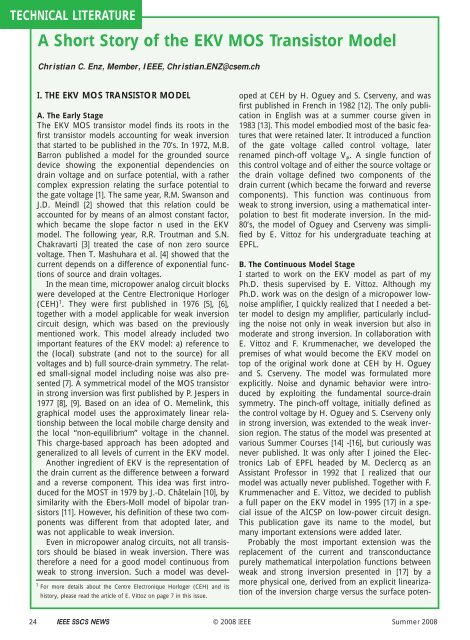Eric Vittoz - IEEE
Eric Vittoz - IEEE
Eric Vittoz - IEEE
You also want an ePaper? Increase the reach of your titles
YUMPU automatically turns print PDFs into web optimized ePapers that Google loves.
TECHNICAL LITERATURE<br />
A Short Story of the EKV MOS Transistor Model<br />
Christian C. Enz, Member, <strong>IEEE</strong>, Christian.ENZ@csem.ch<br />
I. THE EKV MOS TRANSISTOR MODEL<br />
A. The Early Stage<br />
The EKV MOS transistor model finds its roots in the<br />
first transistor models accounting for weak inversion<br />
that started to be published in the 70’s. In 1972, M.B.<br />
Barron published a model for the grounded source<br />
device showing the exponential dependencies on<br />
drain voltage and on surface potential, with a rather<br />
complex expression relating the surface potential to<br />
the gate voltage [1]. The same year, R.M. Swanson and<br />
J.D. Meindl [2] showed that this relation could be<br />
accounted for by means of an almost constant factor,<br />
which became the slope factor n used in the EKV<br />
model. The following year, R.R. Troutman and S.N.<br />
Chakravarti [3] treated the case of non zero source<br />
voltage. Then T. Mashuhara et al. [4] showed that the<br />
current depends on a difference of exponential functions<br />
of source and drain voltages.<br />
In the mean time, micropower analog circuit blocks<br />
were developed at the Centre Electronique Horloger<br />
(CEH) 1 . They were first published in 1976 [5], [6],<br />
together with a model applicable for weak inversion<br />
circuit design, which was based on the previously<br />
mentioned work. This model already included two<br />
important features of the EKV model: a) reference to<br />
the (local) substrate (and not to the source) for all<br />
voltages and b) full source-drain symmetry. The related<br />
small-signal model including noise was also presented<br />
[7]. A symmetrical model of the MOS transistor<br />
in strong inversion was first published by P. Jespers in<br />
1977 [8], [9]. Based on an idea of O. Memelink, this<br />
graphical model uses the approximately linear relationship<br />
between the local mobile charge density and<br />
the local “non-equilibrium” voltage in the channel.<br />
This charge-based approach has been adopted and<br />
generalized to all levels of current in the EKV model.<br />
Another ingredient of EKV is the representation of<br />
the drain current as the difference between a forward<br />
and a reverse component. This idea was first introduced<br />
for the MOST in 1979 by J.-D. Châtelain [10], by<br />
similarity with the Ebers-Moll model of bipolar transistors<br />
[11]. However, his definition of these two components<br />
was different from that adopted later, and<br />
was not applicable to weak inversion.<br />
Even in micropower analog circuits, not all transistors<br />
should be biased in weak inversion. There was<br />
therefore a need for a good model continuous from<br />
weak to strong inversion. Such a model was devel-<br />
1 For more details about the Centre Electronique Horloger (CEH) and its<br />
history, please read the article of E. <strong>Vittoz</strong> on page 7 in this issue.<br />
oped at CEH by H. Oguey and S. Cserveny, and was<br />
first published in French in 1982 [12]. The only publication<br />
in English was at a summer course given in<br />
1983 [13]. This model embodied most of the basic features<br />
that were retained later. It introduced a function<br />
of the gate voltage called control voltage, later<br />
renamed pinch-off voltage V P . A single function of<br />
this control voltage and of either the source voltage or<br />
the drain voltage defined two components of the<br />
drain current (which became the forward and reverse<br />
components). This function was continuous from<br />
weak to strong inversion, using a mathematical interpolation<br />
to best fit moderate inversion. In the mid-<br />
80’s, the model of Oguey and Cserveny was simplified<br />
by E. <strong>Vittoz</strong> for his undergraduate teaching at<br />
EPFL.<br />
B. The Continuous Model Stage<br />
I started to work on the EKV model as part of my<br />
Ph.D. thesis supervised by E. <strong>Vittoz</strong>. Although my<br />
Ph.D. work was on the design of a micropower lownoise<br />
amplifier, I quickly realized that I needed a better<br />
model to design my amplifier, particularly including<br />
the noise not only in weak inversion but also in<br />
moderate and strong inversion. In collaboration with<br />
E. <strong>Vittoz</strong> and F. Krummenacher, we developed the<br />
premises of what would become the EKV model on<br />
top of the original work done at CEH by H. Oguey<br />
and S. Cserveny. The model was formulated more<br />
explicitly. Noise and dynamic behavior were introduced<br />
by exploiting the fundamental source-drain<br />
symmetry. The pinch-off voltage, initially defined as<br />
the control voltage by H. Oguey and S. Cserveny only<br />
in strong inversion, was extended to the weak inversion<br />
region. The status of the model was presented at<br />
various Summer Courses [14] -[16], but curiously was<br />
never published. It was only after I joined the Electronics<br />
Lab of EPFL headed by M. Declercq as an<br />
Assistant Professor in 1992 that I realized that our<br />
model was actually never published. Together with F.<br />
Krummenacher and E. <strong>Vittoz</strong>, we decided to publish<br />
a full paper on the EKV model in 1995 [17] in a special<br />
issue of the AICSP on low-power circuit design.<br />
This publication gave its name to the model, but<br />
many important extensions were added later.<br />
Probably the most important extension was the<br />
replacement of the current and transconductance<br />
purely mathematical interpolation functions between<br />
weak and strong inversion presented in [17] by a<br />
more physical one, derived from an explicit linearization<br />
of the inversion charge versus the surface poten-<br />
24 <strong>IEEE</strong> SSCS NEWS © 2008 <strong>IEEE</strong> Summer 2008




